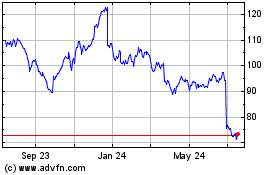Nike's Blowout Underscores How Perception of Safety and Quality Can Affect Reputation
February 21 2019 - 8:16PM
Dow Jones News
By Mengqi Sun
The blowout of a college basketball star's shoe Wednesday
underscored how consumer perception of safety and quality can weigh
heavily on a company's reputation.
Duke University forward Zion Williamson's Nike basketball shoe
appeared to rip apart in the first minute of a rivalry game against
the University of North Carolina.
Mr. Williamson tried to change direction to shake a Tar Heel
defender, but his left foot broke through the side of the shoe. Mr.
Williamson, considered one of best collegiate players, fell to the
ground holding his right knee before limping off the court. He
didn't return to the game.
The prime-time spectacle, which played out on national
television, highlighted a delicate dance between customer
expectations and quality assurance, risk consultants said. Shoes
take a beating, and few customers would expect a pair to last
forever. But shoes tend to degrade over time, not in an
instant.
"Stakeholders are not expecting the shoes to have a failure;
they would be surprised and disappointed," said Nir Kossovsky,
chief executive of corporate reputation insurance company Steel
City Re.
Nike uses sports icons as a means to convey the quality of the
products, he said. The implied message: If it's good enough for the
athletes, it's good enough for average consumers. But the failure
of the shoe under Mr. Williamson -- a high-profile player who has
been projected by some as a likely future star on the professional
level -- challenged that premise. "It didn't hold up," Mr.
Kossovsky said.
How a company responds in moments after an event like this can
help determine the extent of the damage to its reputation. That
often includes some form of acknowledging the issue and reassuring
customers that it is an anomaly, and that the company has controls
in place to ensure that this isn't a failure in its governance or
the company's mission.
Nike attempted that in a statement Thursday. "We are obviously
concerned and want to wish Zion a speedy recovery," the company
said. "The quality and performance of our products are of utmost
importance. While this is an isolated occurrence, we are working to
identify the issue."
The lasting effect on Nike will be determined by consumers and
investors. Some of the indicators for the scale of the impact could
be the extent of movement in equity value, credit default swap
prices and bond prices over time, Mr. Kossovsky said. Nike shares
fell 1% to $83.95 on Thursday.
"The bond guys, they are the most sensitive to risks," he said.
"Their risk assessment is the most accurate." Bonds are a measure
that could suggest material cash flow damage, he said.
"Cash flow risk is the end of state of reputation risk," Mr.
Kossovsky said.
Write to Mengqi Sun at mengqi.sun@wsj.com
(END) Dow Jones Newswires
February 21, 2019 20:01 ET (01:01 GMT)
Copyright (c) 2019 Dow Jones & Company, Inc.
Nike (NYSE:NKE)
Historical Stock Chart
From Aug 2024 to Sep 2024

Nike (NYSE:NKE)
Historical Stock Chart
From Sep 2023 to Sep 2024
